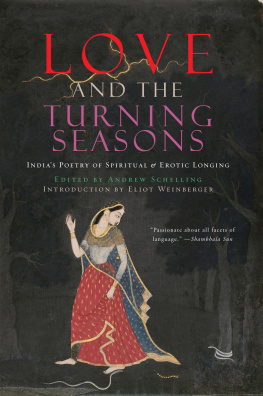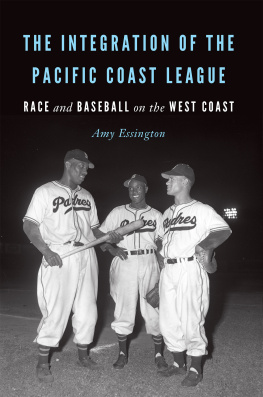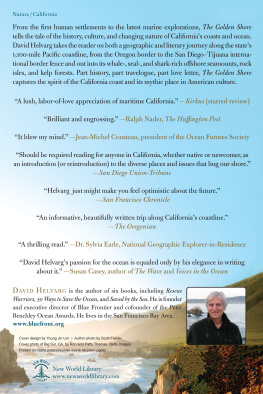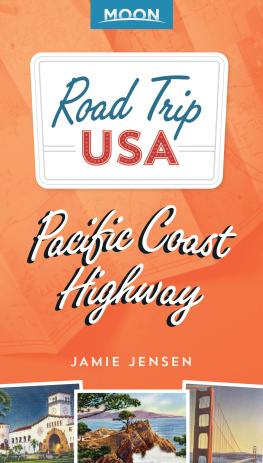
A LSO BY A NDREW S CHELLING
Literature is Not the Longhouse
Bright as an Autumn Moon
The Real People of Wind & Rain:
Talks, Essays, & an Interview
A Possible Bag
From the Arapaho Songbook
Old Tale Road
Two Elk, a High Country Notebook
Wild Form, Savage Grammar
Tea Shack Interior: New & Selected Poetry
The Road to Ocosingo
The Cane Groves of Narmada River
For Love of the Dark One, Songs of Mirabai
Old Growth
The India Book
Dropping the Bow, Poems from Ancient India
E DITING
Love and the Turning Seasons:
Indias Poetry of Spiritual and Erotic Longing
The Wisdom Anthology of North American Buddhist Poetry
The Oxford Anthology of Bhakti Literature
T RACKS A LONG THE L EFT C OAST

Jaime de Angulo and Lynda Sargent at Los Pesares, Big Sur.
Photo by George Cain.

Copyright 2017 by Andrew Schelling
First Counterpoint hardcover edition: May 2017
First paperback edition: 2018
All rights reserved under International and Pan-American Copyright Conventions. No part of this book may be used or reproduced in any manner whatsoever without written permission from the publisher, except in the case of brief quotations embodied in critical articles and reviews.
The chapter Wilderness, Doctors, Poison, Poetry appeared in a somewhat different version as The Songs of Jaime de Angulo in Home Among the Swinging Stars: Collected Poems of Jaime de Angulo , La Alameda Press, 2006, edited by Stefan Hyner.
The Library of Congress has cataloged the hardcover as follows:
Names: Schelling, Andrew, author.
Title: Tracks Along the Left Coast : Jaime de Angulo and Pacific Coast Culture / Andrew Schelling.
Description: Berkeley, CA : Counterpoint Press, 2017. | Includes bibliographical references.
Identifiers: LCCN 2017005032 | ISBN 9781619029255 (hardback) | eISBN 9781619029255
Subjects: LCSH: Angulo, Jaime de. | EthnologistsCaliforniaBiography. | LinguistsCaliforniaBiography. | FolkloristsCaliforniaBiography. | Authors, American20th centuryBiography. | Indians of North AmericaCaliforniaPacific CoastSocial life and customs. | Indians of North AmericaCaliforniaPacific CoastLanguages. | BISAC: BIOGRAPHY & AUTOBIOGRAPHY / Adventurers & Explorers.
Classification: LCC GN21.A6 S35 2017 | DDC 305.80092 [B] dc23
LC record available at https://lccn.loc.gov/2017005032
PAPERBACK ISBN : 978-1-64009-041-5
Cover and interior designed by Gopa & Ted2, Inc.
Cover photographs: Portrait of Jaime de Angulo by Tino Trova. Reprinted by permission from The Hudson Review , Vol. III, No. 3 (Autumn 1950). Copyright 1950, renewed 1978 by The Hudson Review, Inc.; Jaime de Angulo and Blind Hall, ca. 1924; Jaime de Angulo, ca. 1950.
COUNTERPOINT
2560 Ninth Street, Suite 318
Berkeley, CA 94710
www.counterpointpress.com
Printed in the United States of America
Distributed by Publishers Group West
10 9 8 7 6 5 4 3 2 1
Describing events in other than chronological order is a Karok literary technique.
K AROK T EXTS
C ONTENTS
P OISON, BY W AY OF P REFACE
Child, there are so many Coyotes ... wise Coyotes, foolish Coyotes ... thats just the way people are. There have been all kinds of Coyotes ever since the world began.
FROM Shabegok
J AIME DE A NGULO , a maverick self-trained linguist and ethnologist, California wilderness homesteader, novelist, and poet, died in 1950, over sixty years ago. His outsize figure lives on as a vivid presence though: in Northern Californias rural districts, along the jagged Pacific Coast, east into the Sierra Nevada foothills, down towards Taos and Santa Fe, and in a great many backwoods households throughout North America. Once in a while citations of his work show up in linguistic journals. He accomplished quite serious studies, including detailed accounts of languages that have disappeared entirely. People who knew him personally, or who encountered others who knew him, are vanishing; but a tangle of pungent, often contradictory stories continue to get told. Tucked into the gnarled hills back of Big Sur, where de Angulo homesteaded on Partington Ridge a hundred years ago, residents know his name; few are likely to direct you to the house he built, or help you locate the elusive Jaime de Angulo Trail to the crest of the Santa Lucia Mountains.
Once you get onto Partington Ridge the snarl of unmarked deeply rutted dirt roads feels bewildering. In late April 2000, I managed to make my way onto the Ridgehoping to see one more time his house and the rough-hewn little log hunting shack I remembered in the nearby woods. I found a lot of muscular madroa limbs covering roads powdery with alkaline dust, but couldnt get my bearings. Manzanita, poison oak, bay laurel, bright orange poppies climbing the sharp hillsides. Redwood tips and ink-colored Doug fir in the twisted ravines.
One lone walker directed me away from the Ridge when I asked if he knew where I could find Los Pesares, The Sorrows. This is the name de Angulo gave to his ranch, homesteaded in 1916, and where he built a house in the early 1930s. The walker pointed five miles up the arcing, rocky, gorgeous coastline to where a spit of land covered with cypress reached into the glittering ocean. I could just make out a fancy house that had no business being there. This guy, taciturn, bearded, with ragged long hair, walking with a bludgeon for a stave, must have thought I speculated in real estate. Or believed my question a cover. I could have been a federal marshal. Everyone knew there was a lot of dope growing back there, back in the steep hard-to-penetrate hills. Between de Angulos day and our own, the vaqueros the buckeroosof Spanish descent whod first settled the coastline had given way to marijuana trimmers.
Anyhow, by the late 1990s, the road up Partington Ridge had been secured by a locked gate to protect the landowners privacy. The old-timers, Henry Miller wrote of the whole coastal hills region, from his own perch on Partington Ridge in the 1950s, those with huge landholdings, are not eager to see the land opened up. It seems less likely than ever that the baffling web of dirt roads has helpful signposts, even if you do manage to make it past the locked barrier.
In Berkeley, where de Angulo made the other of his two long-term homes, the original Pacifica Radio station, KPFA, renews his reputation, maybe once every ten years rebroadcasting some or all of the nearly one hundred Old Time Stories tapes he recorded the final year of his life. De Angulos broadcasts began shortly after KPFA went on the air April 15, 1949. De Angulos distinct voiceEnglish inflected by Spanish, his native tongue; by French, the language of his childhood; by Basque if he is to be believed about his ancestry; and by a couple of dozen California Indian tongueshas been a defining program. When I tuned into a full rebroadcast in 1984 the station ran two of the more or less twelve-minute segments back to back with radio recordings by another California folklore presence, Alan Watts.
A few years ago I wrote that dog-eared copies of de Angulos book Indian Tales , the collection drawn from his old radio broadcast manuscripts, are household fixtures among California backwoods residentstaking their place alongside chainsaws, work gloves, and spare auto partsnecessities for people who think of themselves like de Angulo did, as freedom loving anarchists, and who have developed skills of self-reliance with regard to their local resources. This statement may strike some as romantic; but Ive been in a good number of households where it is true. Somebody is buying copies of the book Indian Tales has been continuously in print since 1953, making its way from publisher to publisher. A few times its appeared with a new preface. Howard Norman wrote one; so did Darryl Babe Wilson, the Achumawi or Pit River Indian writer.
Next page











